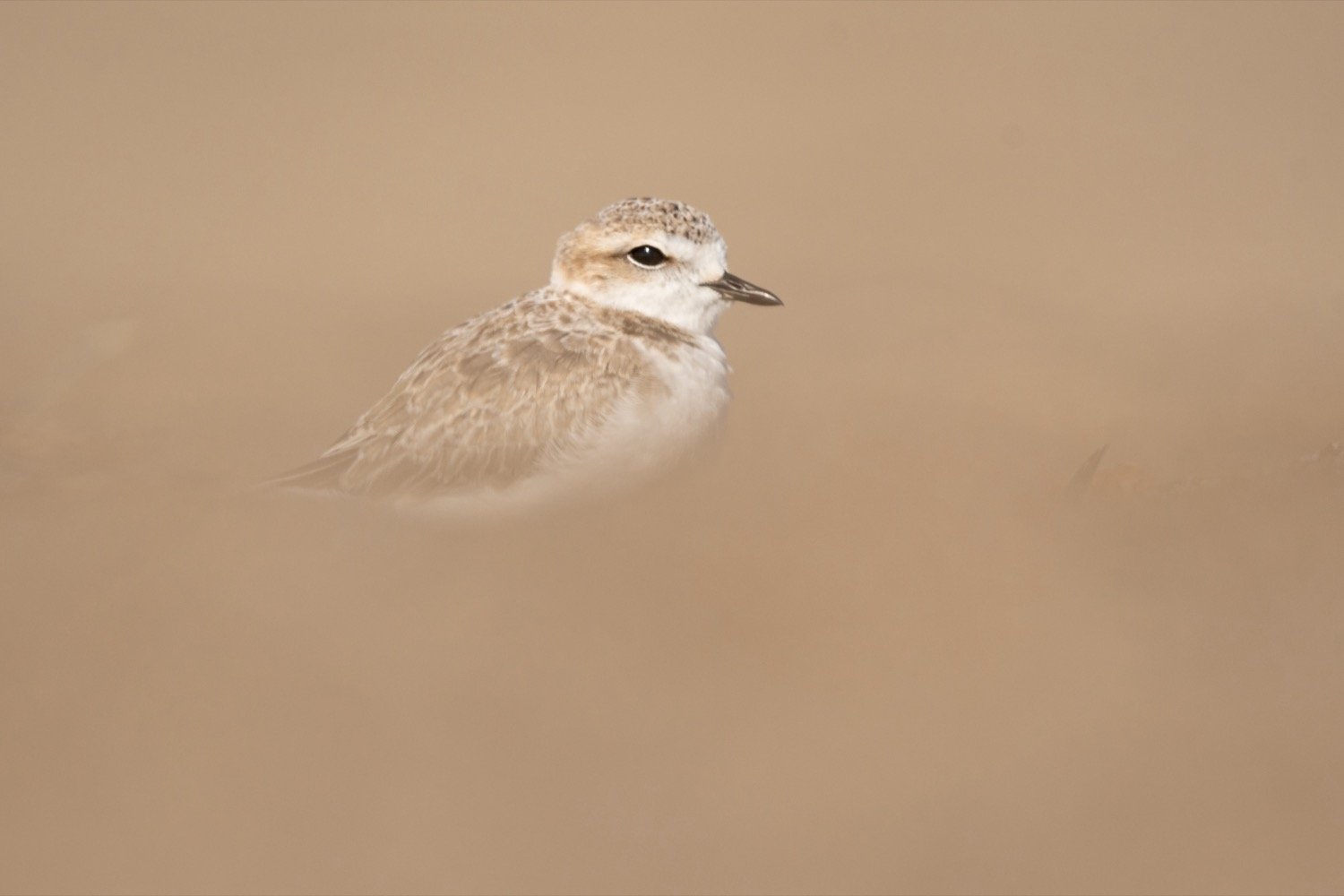Pictures and textual content by Sarah Killingsworth
Matt Lau is scanning for tiny beige spots in a sea of sand.
For the previous 9 years, Lau, a Nationwide Park Service wildlife biologist, has been enjoying this beachfront The place’s Waldo at Level Reyes Nationwide Seashore throughout spring and summer season. He’s in search of western snowy plovers (Charadrius nivosus nivosus) and their nondescript nests, hidden in scrapes within the sand simply above the tideline. His purpose: to assist them survive.

These birds are so well-camouflaged that an unwitting particular person may simply stroll proper by means of their nesting space—destroying their minimal nests and dun-colored eggs.

Discovering the nest is the important thing to defending this federally threatened species. There are an estimated 2,500 western snowy plovers on the entire West Coast and the 2024 breeding inhabitants in Level Reyes Nationwide Seashore was 50 birds; it hit a low in 2012 and varies annually. Different western snowy plovers migrate by means of right here within the winter, however most of Lau’s work focuses on the breeding plovers, which nest right here 12 months after 12 months.
The Nationwide Park Service is charged with defending the plovers from predators—amongst them, coyotes and nice horned owls, in addition to people’ canine companions.
Just lately, one extremely sensible predator has been going after nesting adults—including a brand new problem to defending this species.

For the final a number of years, I’ve been trekking out to the seaside with my digicam to doc Lau’s work monitoring the plovers at Level Reyes.
Mere human presence can appeal to ravens and different predators, so I stroll in Lau’s tracks within the sand, we wipe away our footprints round nests, and he works rapidly at every nest—usually a half-hour or much less, even when banding chicks.
Throughout bandings, I maintain look ahead to predators—significantly raptors and ravens. If a black chook exhibits up, and appears all in favour of what we’re doing, we depart.

The Park Service has accomplished loads for the Level Reyes plovers, like restoring dunes, stationing docents on the trailhead to teach guests, and symbolically fencing off seaside areas. The principal safety for the nests themselves is exclosures—wire cages that plovers can simply run out and in of, however that maintain out the various animals that wish to eat them. Chick survival “was dismal” earlier than these cages had been added in 2002, Lau says.
However exclosures have their dangers: they’re far more seen than the nests themselves. For years, NPS has been tweaking the exclosure design, and in 2022 moved to lower-profile “mini-exclosures.” Whereas 2022 noticed a document variety of fledglings, troubling losses of adults started in 2023. The exclosures that shield eggs and chicks might take their toll on adults.

Fluffballs on toothpick legs, western snowy plover chicks are cellular as quickly as they hatch. Inside a day, they start to maneuver away from the nest website, usually accompanied by their father (whereas their mom leaves to doubtlessly nest once more with one other male). They take a month to fledge, however chicks get far on foot—touring so far as a half-mile from the nest in simply the primary few days, in accordance with Lau.
The three pale, speckled eggs in every nest not often produce greater than two fledglings. Usually it’s just one, or none. Fifty nests in 2023 yielded simply 19 fledglings, whereas in 2024, 41 nests produced a document 31 fledglings. The numbers differ annually, however traditionally, Level Reyes has been a inhabitants sink.
Ravens are a major predator of the western snowy plover eggs and chicks. And sometimes it’s people that carry them round, with our meals and our trash and our hubbub. Our off-leash canine, driftwood constructions, and close by ranching operations can all appeal to ravens. And as soon as ravens are within the neighborhood, they’re extra prone to spot the exclosures, eggs or chicks.

Western snowy plovers use a basic distraction approach to guard their nests and offspring. When a dad or mum perceives a menace, it races away from the nest, dragging its wings and tail in a feigned harm to divert the predator.
However as quickly as plovers depart the exclosure, they’re in danger. And a few ravens, it appears, are taking benefit.
Final 12 months, 37 of 57 chicks perished, and extra considerably, 5 nesting adults disappeared. That was an enormous setback for the small inhabitants. The lack of grownup birds that had efficiently raised fledglings in Level Reyes previously was particularly arduous on Lau, who is aware of the birds individually by the mixtures of bands they put on. Cameras had been added, to assist establish the trigger. No raven was caught within the act, however footage confirmed the birds circling close by exclosures.
In 2024, after shedding two extra incubating adults from nests, Lau put in extra cameras and eliminated exclosures from the nests in that space, hoping to guard the remaining breeding adults.

This 12 months, a organic technician working with Lau noticed a raven taking off from an exclosure and killing an grownup western snowy plover. The remark was a primary for Level Reyes, and presumably anyplace on the West Coast.
There have been different losses of a number of incubating adults, although. In June 2006, a Humboldt County inhabitants of plovers misplaced eight incubating adults within the span of every week, most probably to a nocturnal predator like an amazing horned owl. Managers there eliminated all exclosures and haven’t used them since. Since then, biologists at many Northern California places have been hesitant to make use of exclosures in any respect. For the following season in Level Reyes, Lau will use extra cameras, step up nest monitoring, and take away exclosures from areas the place adults have been preyed upon.
And relying on what occurs subsequent season, the park service will take into account different ways, like killing ravens or relocating predators. That has labored effectively with nice horned owls, for plover populations south of Level Reyes—however not with diurnal predators like peregrine falcons and northern harriers, which have simply flown proper again to the survey website. Excessive priorities are lowering rubbish on the seashores and guaranteeing that ranches clear up the useless cows and cattle-feeding areas that appeal to ravens.

All this work should proceed, in accordance with the plovers’ species restoration plan, till the inhabitants in Level Reyes grows to 64 breeding pairs and stays there. And it’s a great distance from that. Western snowy plovers developed for a distinct segment that we’ve modified on them—whereas the ravens maintain adapting to it. “Generalists,” says Lau, “are going to win this evolutionary battle, within the time of people.”
For now, it appears, the plovers want us: a protector that’s no less than as sensible and adaptable as their predators.
In case you go
Seeing Snowy Plovers
Throughout the summer season nesting season, sections of the seashores and dunes in Level Reyes are closed to guard the breeding western snowy plovers and their nests. It’s simpler to see western snowy plovers in Level Reyes throughout the fall and winter, when a whole bunch of birds in non-breeding flocks congregate on seashores. One of the best seashores for viewing them are Abbotts Lagoon, North Seaside and Limantour Seaside. However watch out. Winter is a high-mortality time for these birds, which face chilly climate, storms, overwintering falcons, plus guests and canine. So, please observe from a distance and keep away from disturbing the birds from their “foxholes” if they’re resting in indentations within the sand.
